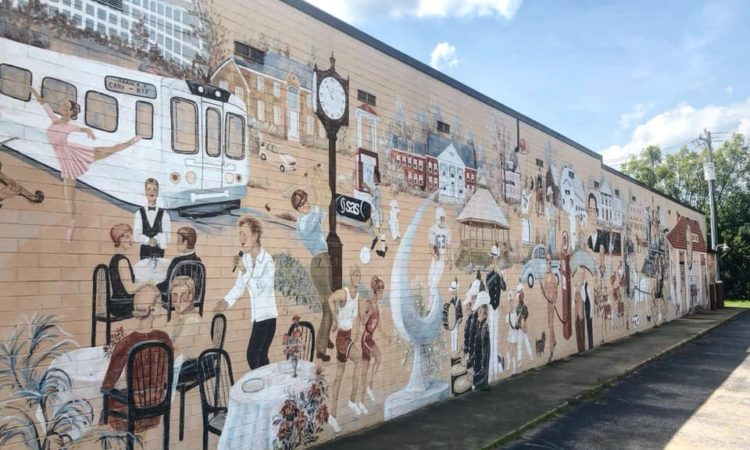If you’ve ever had breakfast at the La Farm Bakery on Chatham and Harrison, you’ve likely looked at the historic mural, painted like a cryptogram of more than 150 years of Cary’s stories. Some of the buildings and faces depicted are self-explanatory — the old Cary High School is clearly recognizable, and Clay Aiken is seen performing alongside a violinist. And who wouldn’t recognize Mr. Ashworth, standing beneath the Drug Store sign?
However, the mural is also full of mysteries. Who is the old-timey doctor standing in military uniform outside the old train station, and who is the elderly lady in a white bonnet sitting near him? Why are cats, dogs, and goats wandering the streets of downtown? Who is “Ms. Cathey”? Where is that iconic, white Kildaire Farm barn? What is “The Cricket”? Is there really a “Z” department store in Cary?
Cary native Val Fox did more than paint Cary’s history on that wall; she painted personal stories, Easter eggs, and clues about her eight decades of memories growing up in the “good old days” of this small community. Every person on her mural played a role in the town’s story.
Let’s look at each section of the mural and, with help from the artist herself, decipher the clues, secret identities, and hidden history portrayed in the iconic mural.
Who’s Sitting at the Cary Train Station?
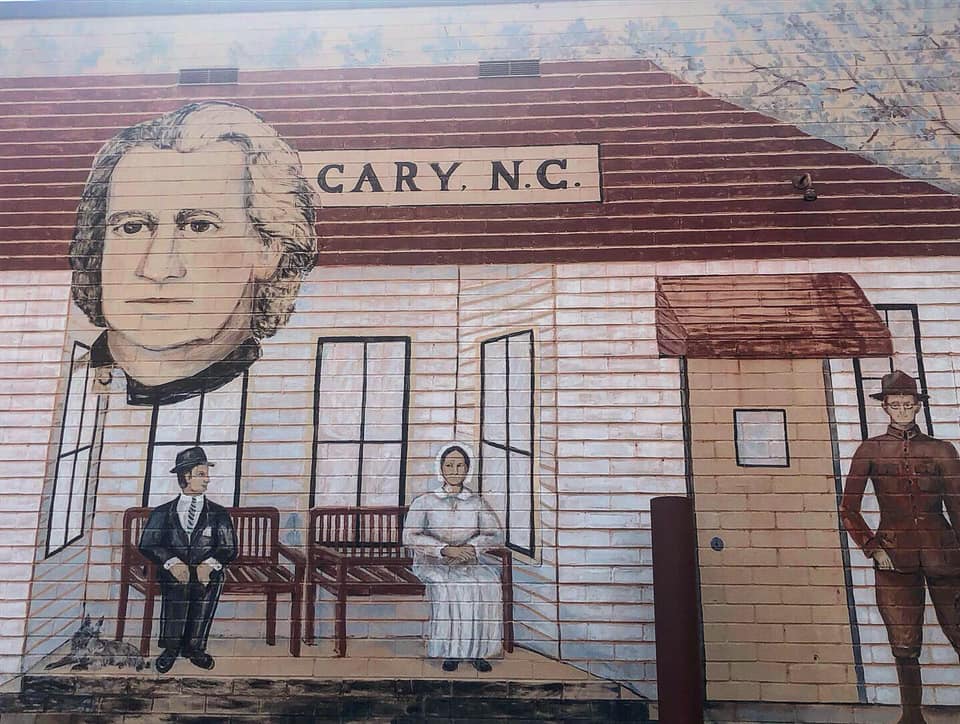
The mural’s story “reads” from right to left, beginning with the Cary train station and the enormous head of Samuel Cary. Yes – if you’ve ever wondered about the sepia-toned face hovering over the station, that is the namesake of our town. Samuel Cary was a traveling preacher who inspired Frank Page, who later officially established our town.
The train station itself is a marker of a major turning point for the town. Eli Yates provided land for the North Carolina Railroad to pass through the community in 1852, and by 1854 the community’s level land and preferable topography brought growth and wealth that literally put Cary on the map. The Page family donated land for the railroad station. In fact, from one end of Academy Street to the other, many of the most recognizable buildings in modern day downtown are a result of Frank Page’s generosity or business acumen. From the modern day Cary Arts Center to the Page-Walker Arts & History Center capping each end of downtown, Frank Page not only pushed for Cary’s official incorporation as a town, he served as its first mayor and built much of the infrastructure still visible today.
“Mrs. Jones was also a big part of Cary’s story, so I have her seated on the bench outside the train station,” explains Fox. The Jones House, built in 1803, is part of pre-incorporation history, when Cary was not yet a town. The home served as an important stagecoach stop and tavern. Since government delegates and representatives traveled often, they relied on taverns as important meeting places. In fact, the governors of NC and SC met here in the antebellum period; according to oral legend, President Polk also stayed there.
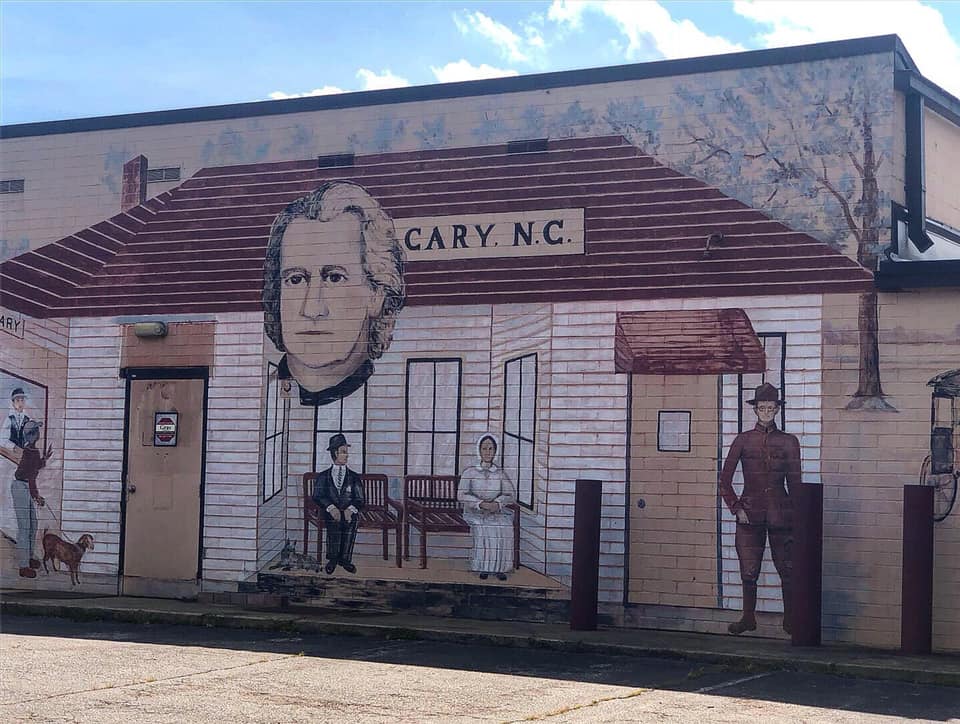
Standing guard by the railway station door, Doctor Templeton appears in his military uniform. In 1885 he opened a medical practice in Cary, acting as a traveling house doctor. At age 62, he enlisted in the military to fight in WWI. His intern, Dr. Frank Yarborough, carried on after he passed away in 1932.
“Cary was still segregated in this era, so I included the two doors at the train station to show when it still had two entrances,” shares Fox.
Secret Portraits Hidden in Plain Sight
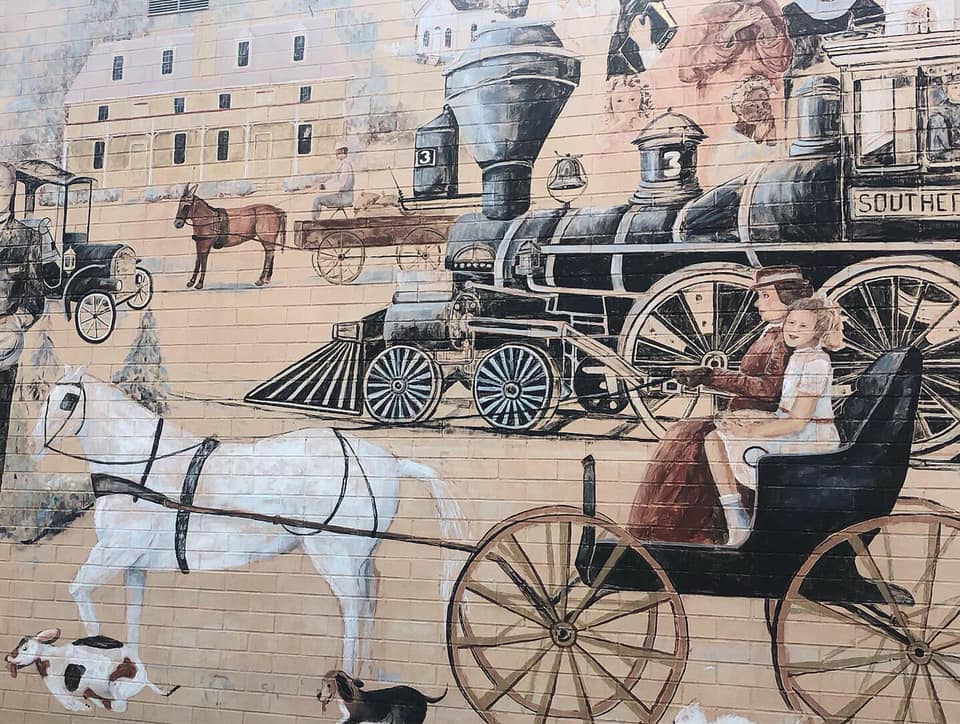
“Well,” smiles Fox, “You know I said I wouldn’t put any personal portraits in the mural, but I did put a few people in there for fun.”
She included secret portraits of friends who helped make the mural a reality.
“In the horse-drawn stagecoach I painted Loyd Sorrell’s daughter and wife. Of course, they didn’t really live in that time period, but I took artistic liberty,” she laughs. Before La Farm Bakery occupied the building, it belonged to Loyd Sorrell and housed his paint and hardware store. He provided a space inside for Fox’s gallery, and provided his exterior wall for her mural.
Alongside Sorrell, she also gained encouragement from Ralph Ashworth and Dick Ladd, who first suggested she paint a mural.
“I told Mr. Ashworth I wasn’t going to paint his portrait, but if you look closely you may recognize that smile and perhaps Paul peeking over his shoulder,” she says. Given Ralph Ashworth’s significant role as one of only two pharmacies in Cary, as well as the historic and community value of the nostalgic soda foundation and hotdogs, it seems fitting he appears.
“I also painted a football player with Loyd Sorrell’s number 63,” she says. “Or at least I thought I did! One day a lady came up to me, bustling with excitement, saying, ‘Oh!! You put my son in your mural!’ and I thought, ‘Oh, I did?’”
Keen-eyed viewers may also recognize Clay Aiken, serenading a group of Cary-ites eating brunch in downtown. “I just love his music,” she says.

Fox also included a deeply sentimental scene of a teacher named Miss Cathey. Ruth Cathey, a second grade teacher who eventually become the principal of Briarcliff Elementary, is standing in front of a classroom of eager students. “She was my stepmother.”
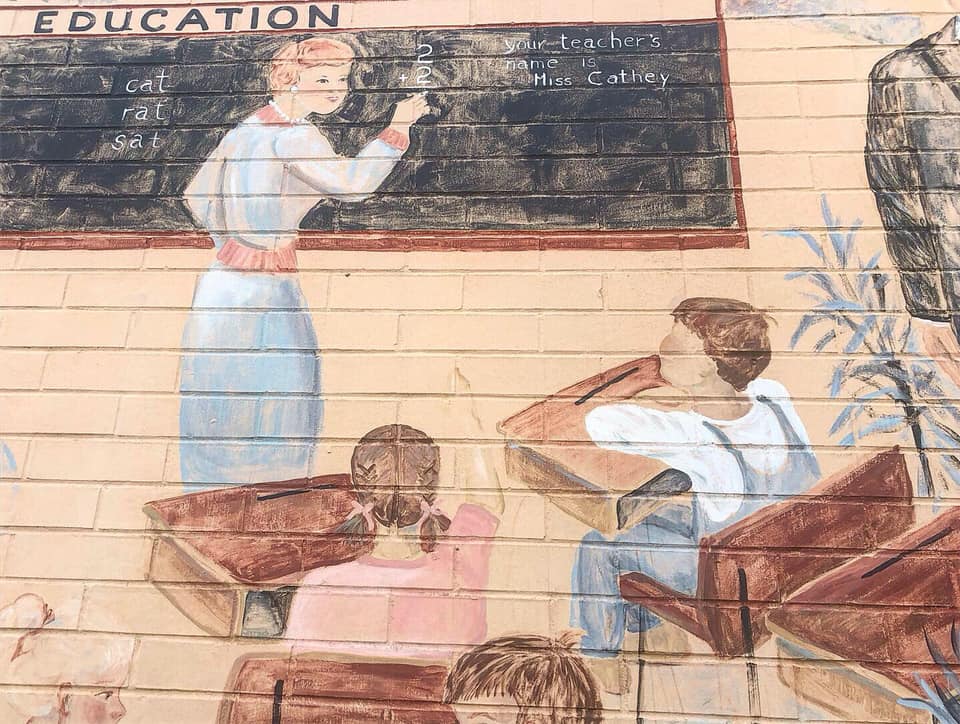
Finally, Fox points to the small horse and rider galloping past Kildaire Farm on top of the mural. She smiles wistfully, saying, “That’s me.” Fox, it seems, always loved riding horses. Now, a little piece of her can ride her horse forever.
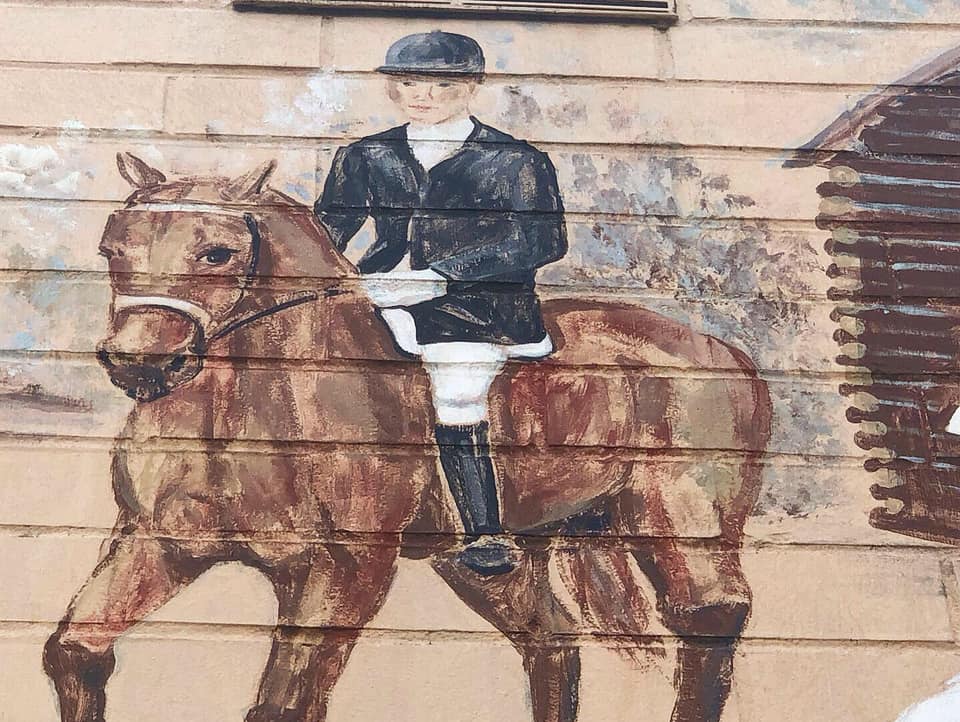
Her sense of artistic whimsy and personal history makes the painting an important primary source — a story shared from the memory of a Cary native.
Iconic Buildings from Cary History
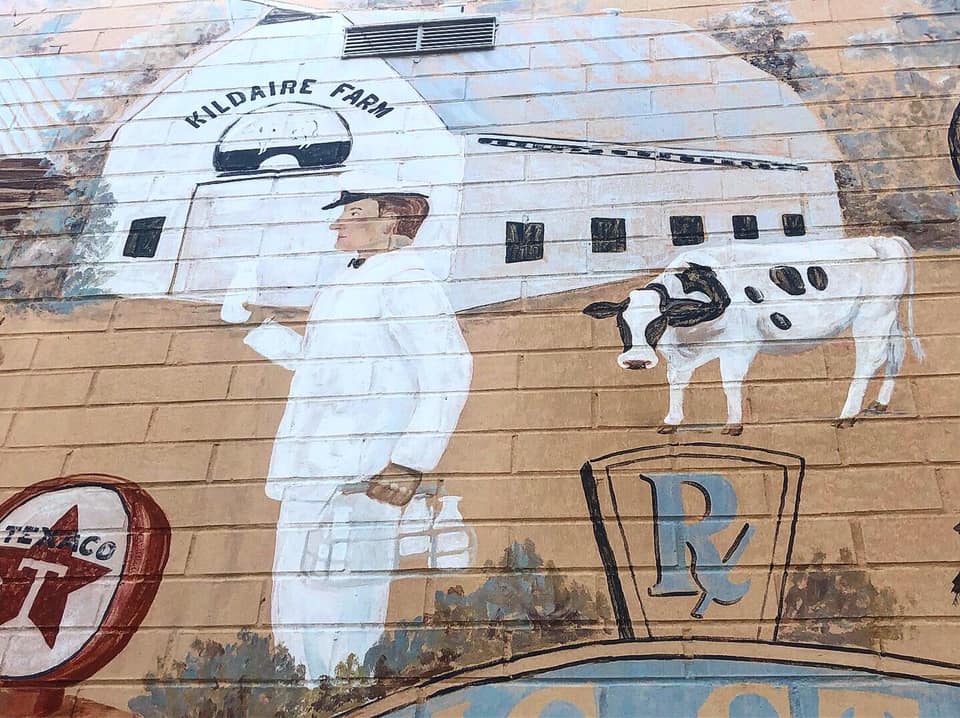
It’s hard to imagine that Kildaire Farm Road, a major artery through Cary, was once a lazy dirt road meandering around an actual barn. “This is Kildaire Farm,” she says, indicating to the rustic white barn with cows grazing out front. “I wish we still had that building,” she says nostalgically. Today, the car wash and gas station at the crossroads of Kildaire and Cary Parkway marks where this icon once stood.
Of course, many readers will recognize Frank Page’s buildings — Cary Academy and the Page-Walker Hotel. More than a century later, these historic landmarks are still a center of culture and community in Downtown Cary.
The Guess House, better known as The Pink House, is also an iconic sight on Academy Street. Built in the 1830’s, it spent more than a few years run-down and abandoned. Sheila and Carroll Ogle rescued and restored the historic home. Fox laughs, “Sheila’s husband didn’t like it being painted pink, but a newspaper quoted, ‘It takes a real man to live in a pink house!’”
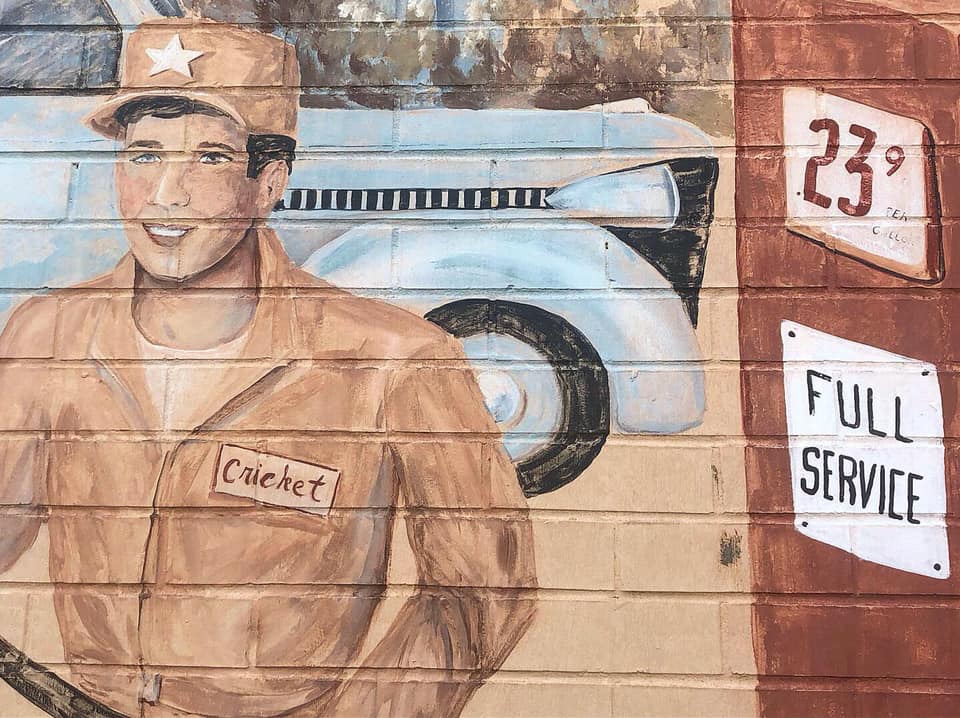
The man with the gas pump is Jerrell Spencer, who is associated with Cricket Service Station. The Cricket sat at the fork between US-1 and the road to Chapel Hill, where travelers from New York to Florida would stop for gas. “Cary didn’t have many gas stations back then, so a lot of people went to the Cricket,” says Fox.
Since Cary takes it name from a preacher, it’s not surprising that churches were a very important part of the town’s culture. “Oh yes, everyone went to church,” recalls Fox. “Cary was a Christian town. And this group of folks I painted around the churches, they’re white, black, young, middle-aged, and elderly. It’s all the people in our little Cary — and to show Cary being centered around the church.”
“I remember when on Sundays no one could work, go see a picture show, or even play cards. It was a day of rest,” she recalls. “We ate large, home-cooked meals with neighbors, and animals like cats and dogs roamed free without collars. I loved the little animals.”
Then and Now
Fox’s work can be found as far away as Jerusalem, but she has painted many scenes locally as well. She has a mural inside The Pink House, and painted another one at a small tea shop across from Sorrell’s. Some can still be seen in homes and businesses around the Triangle, and some have been painted over in the years since. However, she truly hopes her Cary – Then and Now mural stands the test of time, to tell the story of Cary to generations of new Caryites.
Much of Cary’s growth comes from new citizens moving in from out of state. Therefore, the history is sometimes forgotten as fewer and fewer people are around who remember those old stories. Val Fox’s mural, created by someone who remembers the good old days of Cary, is not just a piece of history — it’s a primary source, an oral history, and a moment in time.
As the mural ages, Fox says she would love to see high school or college students come help keep the mural up, freshening the paint and lines. She would love to see it last generations, as new generations of young Caryites help keep the history alive.

